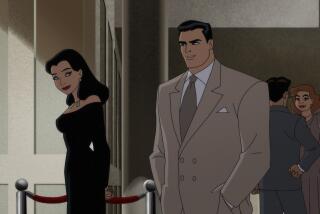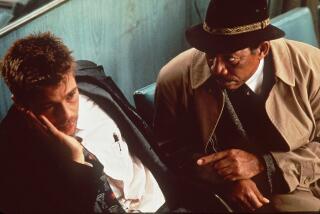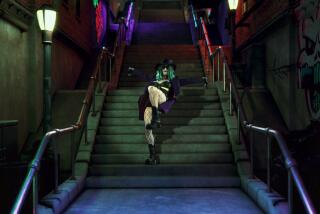A bat never out of hell
Given THE success of “Batman Begins” three years ago, adventurous, eclectic director Christopher Nolan could have gone anywhere and done anything with his next film. So why did he elect to return to the mythical city of Gotham, to the confines of a superhero movie and the narrow world of a caped crusader imprisoned by the secret of who he really is?
That sequel, “The Dark Knight,” answers all those questions with a vengeance. To see it is to understand that Nolan and his co-writer brother Jonathan saw a chance to go deeper into familiar characters and mythology, a chance to meditate on darker-than-usual themes that have implications for the way we live now. A chance to disturb us in the ways these kinds of movies rarely do.
With Christian Bale returning in the title role and Heath Ledger giving a shocking, indelible performance as his arch-nemesis the Joker, “The Dark Knight” may be the most hopeless, despairing comic-book movie in memory. It creates a world where being a superhero is at best a double-edged sword and no triumph is likely to be anything but short-lived.
Because these kinds of movies are only as strong as their villains, a good part of the credit for the potency of “The Dark Knight” has to go to the unusual and unusually creepy and sadistic way the Joker was conceptualized by the Nolans and David S. Goyer (who has a story credit) and played by Ledger in what turned out to be his last completed screen role. The Joker’s is a different kind of evil than we’re used to, one that is harder for both Batman and the audience to dismiss than what Jack Nicholson did with the part nearly two decades ago.
“The Dark Knight,” an allusion to the hugely influential Frank Miller graphic novel “Batman: The Dark Knight Returns,” begins in what should be good times for our hero. While Gotham still struggles with lawlessness, his crime-fighting brand is established, he is secure in his secret identity as playboy billionaire Bruce Wayne and he has a loyal support group in butler Alfred Pennyworth (Michael Caine), tech wizard Lucius Fox (Morgan Freeman) and police Lt. Jim Gordon (Gary Oldman). Plus he is hopeful that his example will get the citizens of Gotham to do the right thing.
Only it isn’t working that way. It’s not the good Batman does but the vigilante nature of his methods (“Batman: Crusader or Menace?” screams a TV news report) that people focus on. Bale’s dead-serious demeanor helps define a character who’s troubled that no one without a mask has stepped up to help and increasingly worried that the act of taking the law into his own hands will further destabilize the situation.
Batman’s best hope for an ally willing to show his face is crusading young Dist. Atty. Harvey Dent, but there are problems even here. Dent is going out with Rachel Dawes (Maggie Gyllenhaal, stepping in for Katie Holmes), once the love of Bruce Wayne’s life, and he’s played by Aaron Eckhart, a square-jawed actor who specializes in characters you’re never sure you can completely trust.
More than that, “Dark Knight’s” director of photography and longtime Nolan collaborator Wally Pfister has created a bright but tainted Gotham world (Chicago was the main location) where even in daylight the mood of overwhelming bleakness is characterized by the kind of untrustworthiness the sun itself is hopeless against.
Not only Pfister’s cinematography but all of “The Dark Knight’s” production values are first-rate. With cost being no object in a reported $180-million budget and a director of Nolan’s formidable abilities in charge, this is powerful, propulsive filmmaking in which elements that must have taken an eternity to set up stay on screen no longer than they absolutely need to.
Even at 2 hours and 32 minutes, “Dark Knight” moves right along (Lee Smith was the editor, Hans Zimmer and James Newton Howard collaborated on the driving score). Nolan and Pfister have actually upped the ante by filming six of the film’s action sequences, including the remarkable flipping of an 18-wheel, 40-foot tractor-trailer, with a 65-millimeter Imax camera, meaning that they have an extra sharpness when shrunken to fit into a 35mm print.
One of those shot in Imax was the film’s opening set-piece, a bank robbery pulled off by a gang of men in clown masks, which symbolizes the moral abyss Gotham is falling into. For the bank turns out to be a mob bank, causing a gangland minion to scream as he is shot down, “Criminals used to believe in things like honor, respect.” Replies the Joker, “What doesn’t kill you makes you stranger.”
Yes, it is the Joker who’s behind this caper, and with his disfigured face, his white makeup, kohl-black eyes and smeared red lips, few people are stranger. Always a consummate professional, Ledger threw himself into a role he clearly relished, giving a transfixing performance as a whiny-voiced god of chaos whose hard-core nihilism is bone-chilling.
For it’s what he represents, not what he looks like, that is finally the horror of the Joker. He has no scruples, no morals, no goal except anarchy, no plan except the end of planning. As Alfred patiently explains, “Some men aren’t looking for anything logical, like money. They can’t be bought, bullied, reasoned or negotiated with. Some men just want to watch the world burn.”
While the Joker understands perfectly that a highly moral opponent like Batman is a welcome gift as far as he’s concerned, for Batman the matchup is much more wrenching. Can he live with what he would have to become to effectively fight the Joker and his spawn? Can he accept the unacceptable things that have to be done to be the hero? Can there be an ending to his story, and to this film, that creates a sense of closure, a sense of peace? It’s a very good question, and you’ll have to see “The Dark Knight” if you want to find out.
--
--
“The Dark Knight.” MPAA rating: PG-13 for intense sequences of violence and some menace. Running time: 2 hours, 32 minutes. In general release.
More to Read
Only good movies
Get the Indie Focus newsletter, Mark Olsen's weekly guide to the world of cinema.
You may occasionally receive promotional content from the Los Angeles Times.











